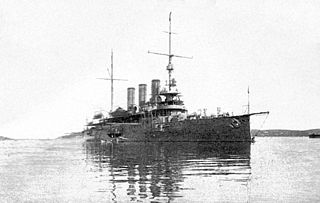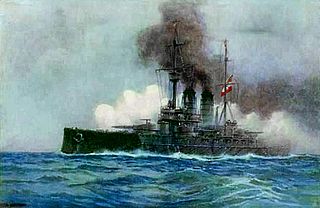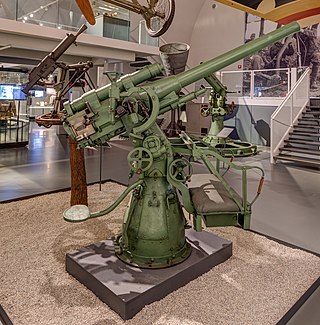
SMS Zrínyi was a Radetzky-class semi-dreadnought battleship (Schlachtschiff) of the Austro-Hungarian Navy, named for the Zrinski, a Croatian-Hungarian noble family. Zrínyi and her sisters, Erzherzog Franz Ferdinand and Radetzky, were the last pre-dreadnoughts built for the Austro-Hungarian Navy.

SMS Sankt Georg was the third and final armored cruiser of the Austro-Hungarian Navy. She was built at the Pola Arsenal; her keel was laid in March 1901, she was launched in December 1903, and completed in July 1905. Her design was based on the previous armored cruiser Kaiser Karl VI, with the primary improvement being a stronger armament. Sankt Georg, named for Saint George, was armed with a main battery of two 24-centimeter (9.4 in) guns, five 19 cm (7.5 in) guns, and four 15 cm (5.9 in) guns.

The Radetzky class was a group of three semi-dreadnought battleships built for the Austro-Hungarian Navy between 1907 and 1910. All ships were built by the STT shipyard in Trieste. They were the last pre-dreadnoughts built by the Austro-Hungarians, and the penultimate class of any type of Austro-Hungarian battleship completed. The class comprised three ships: Radetzky, Erzherzog Franz Ferdinand, and Zrínyi. They were armed with four 30.5-centimeter (12.0 in) guns in two twin turrets and eight 24 cm (9.4 in) guns in four twin turrets.

The QF 3-pounder Hotchkiss or in French use Canon Hotchkiss à tir rapide de 47 mm were a family of long-lived light 47 mm naval guns introduced in 1886 to defend against new, small and fast vessels such as torpedo boats and later submarines. There were many variants produced, often under license which ranged in length from 32 to 50 calibers but 40 caliber was the most common version. They were widely used by the navies of a number of nations and often used by both sides in a conflict. They were also used ashore as coastal defense guns and later as an anti-aircraft gun, whether on improvised or specialized HA/LA mounts.

The Habsburg class was a group of pre-dreadnought battleships built by Austria-Hungary at the turn of the 20th century. They were the first sea-going battleship built by Austria-Hungary since the central battery ship Tegetthoff in 1876. The class was composed of three ships: Habsburg, Árpád, and Babenberg. They were armed with three 24 cm (9.4 in) guns in two turrets and were capable of slightly better than 19.5 knots at full speed. Habsburg and Árpád were modernized in 1910–11.

SMS Erzherzog Karl was a pre-dreadnought battleship built by the Austro-Hungarian navy in 1902. The lead ship of the Erzherzog Karl class, she was launched on 3 October 1903. They were assigned to the III Battleship Division.

SMS Erzherzog Franz Ferdinand was an Austro-Hungarian Radetzky-class pre-dreadnought battleship commissioned into the Austro-Hungarian Navy on 5 June 1910. She was named after Archduke Franz Ferdinand. The first ship of her class to be built, she preceded Radetzky by more than six months. Her armament included four 30.5 cm (12 in) guns in two twin turrets, and eight 24 cm (9.4 in) guns in four twin turrets.

SMS Erzherzog Ferdinand Max was a pre-dreadnought battleship built by the Austro-Hungarian Navy in 1902. The second ship of the Erzherzog Karl class, she was launched on 21 May 1905. She was assigned to the III Battleship Division.

SMS Erzherzog Friedrich was a pre-dreadnought battleship built by the Austro-Hungarian Navy in 1902. The second ship of the Erzherzog Karl class, she was launched on 30 April 1904. She was assigned to the III Battleship Division.

The Monarch class was a class of three coastal defense ships built by Austria-Hungary at the end of the 19th century. The Monarchs were the first ships of their type to utilize turrets. The class comprised three ships: SMS Monarch, SMS Wien, and SMS Budapest, each armed with four 240 mm (9 in) L/40 guns in two turrets and capable of 15.5 knots at full speed. Budapest was fitted with slightly more modern and powerful engines, giving her a top speed of 17.5 knots.

SMS Kaiser Karl VI was the second of three armored cruisers built by the Austro-Hungarian Navy. She was built by the Stabilimento Tecnico Triestino in Trieste between June 1896 and May 1900, when she was commissioned into the fleet. Kaiser Karl VI represented a significant improvement over the preceding design—Kaiserin und Königin Maria Theresia—being faster and more heavily armed and armored. She provided the basis for the third design, Sankt Georg, which featured further incremental improvements. Having no overseas colonies to patrol, Austria-Hungary built the ship solely to reinforce its battle fleet.

SMS Kronprinz Erzherzog Rudolf was a unique ironclad warship built for the Austro-Hungarian Navy in the 1880s, the fleet's last vessel of that type. The ship was laid down in January 1884, launched in July 1887, and completed in September 1889. She was armed with a main battery of three 30.5-centimeter (12 in) guns and had compound steel plating of the same thickness on her armored belt. The ship had an uneventful career, in large part due to her rapid obsolescence. She made trips to foreign countries to represent Austria-Hungary, but was reduced to a coastal defense ship by 1906. She continued in this role through World War I, based at Cattaro Bay, where her crew took part in the Cattaro Mutiny in early 1918. After the war, Kronprinz Erzherzog Rudolf was transferred to the Navy of the Kingdom of Serbs, Croats and Slovenes, renamed Kumbor and classed as a coastal defence ship, but she remained in their inventory for only a year, being sold for scrap in 1922.

The Škoda 10 cm K10 was a 100 mm (3.9-inch) naval gun of the Austro-Hungarian Navy used as tertiary armament on semi-dreadnought battleships and as primary armament on scout cruisers and destroyers during World War I. After World War I, variants of the Škoda 10 cm K10 were widely produced in Italy as the 100/47 series of guns, which served in a number of roles, on a wide variety of ships, with a number of navies.
The Škoda 15 cm K10 was a naval gun of the Austro-Hungarian Empire that was used by the Austro-Hungarian Navy during World War I. The gun was actually 149.1 mm, but the classification system for artillery rounded up to the next highest centimeter. The 15 cm K10 was called cannon 149/47 by the Italians and was used by the Italian Navy as coastal artillery during World War II.
The Škoda 19 cm vz. 1904 was a naval gun of the Austro-Hungarian Empire that was used by the Austro-Hungarian Navy during the World War I. The 19 cm vz. 1904 was also used by the Italian Navy and Italian Army as coastal artillery during World War II. The Italians referred to it as the 190/39.

The Škoda 7 cm K10 was a dual-purpose gun of the Austro-Hungarian Empire that was used by the Austro-Hungarian Navy during World War I. The gun was actually 66 mm, but the classification system for artillery rounded up to the next highest centimeter. The 7 cm K10 was also used by the Italian Navy on ships ceded as war reparations and as coastal artillery during World War II. The Italians referred to it as the 66/47.

The Škoda 30.5 cm /45 and Škoda 30.5 cm /45 K10 were a family of related naval guns of the Austro-Hungarian Empire that were used aboard the last classes of pre-dreadnoughts and dreadnoughts of the Austro-Hungarian Navy during the World War I. Guns salvaged from these ships after World War I were later used by the Royal Italian Army as coastal artillery during World War II.

The 24 cm Schnelladekanone Länge 40, abbreviated as 24 cm SK L/40, was a German naval gun developed in the years before World War I that armed a number of the Imperial German Navy's pre-dreadnought battleships and armored cruisers. Later guns removed from these ships were converted to coastal artillery and were used during World War I and World War II. The actual bore diameter was 23.8 cm (9.4 in), but the classification system for artillery rounded up to the next highest centimeter.
The Škoda 24 cm L/40 K97 was an Austro-Hungarian naval gun developed in the years before World War I that armed a class of pre-dreadnought battleships and armored cruisers of the Austro-Hungarian Navy. The actual bore diameter was 23.8 cm (9.4 in), but the classification system for artillery rounded up to the next highest centimeter.

















